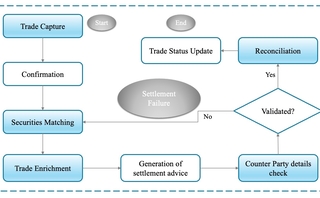Waters Wrap: Operational efficiency and managed services—a stronger connection
As cloud, AI, open-source, APIs and other technologies evolve, Anthony says the choice to buy or build is rapidly evolving for chief operating officers, too.

OES 2023
First things first: this Wednesday, October 18, WatersTechnology, our sibling publication Risk.net, and research firm Chartis, are hosting a new event called the Operational Efficiency Summit (OES). If you work at a bank, broker-dealer, asset manager or some other end-user firm, it’s free to attend. I don’t work in sales, so I have nothing to sell you, but I hope if you’re a subscriber and can get to midtown, you’ll swing by for at least part of the day, as we have a bunch of good speakers on the agenda, which can be found here. (To register, click here; if you have questions, hit me up: anthony.malakian@infopro-digital.com.)
“Everyone blames operations a lot. But if nobody hears from you for a year, they wonder what you’re doing.”
“We’re the engine that makes everything run. And that, that alone, is what makes or breaks winning mandates—it’s not performance; it’s the infrastructure.”
That’s how two bank chief operations officers put the state of tech & ops to me recently. It’s a common theme for people in the world of technology to lament the fact that everyone wants things to run efficiently, and they freak the fuck out when shit hits the fan. Nature of the beast, I guess.
But as one of those COOs put it: “Things have to be right at 9:30. We need to make sure everything is right when the market opens. We need to make sure the PMs and traders are comfortable that the information they’re receiving is good. We need to ensure that all the connections are ready to go. So for all that stuff, having technology and automation and reporting—when things go wrong throughout the day and night, you can address it and troubleshoot it in a very quick manner.”
That leads to the need to create detailed governance structures and automation to understand best what a breakdown looks like through the trade lifecycle. But that can create what might seem like inefficiency.
“Adding these extra processes is seen as an inhibitor to getting things done,” says the second COO. “What they don’t realize is that in the long term, it’s actually much better to put out fewer fires, having less to worry about before trading begins.”
Starting in 2008, as tech & ops teams were cut to the bone and new regulatory structures were put in place, automation became the raison d’être for almost every bank operations manager. That push started in the area of reporting but has slowly bled into all aspects of the trade lifecycle.
Some like to use the word outsourcing, some like to say managed services—while there are differences between the two, I often find that bank folks use them relatively interchangeably. I sort of will for this column, too. Please forgive me.
The fact is, though, that banks are increasingly embracing the cloud—well, everyone is, not just banks. The point being, that wasn’t necessarily the case a decade or so ago. That has also led to the rise of, first, software-as-a-service, and now fucking EVERYTHING-as-a-service. Add to that, rapid advancements in the field of machine learning and more wide-spread adoption of open-source tools and APIs, has meant that, one, it’s become easier to analyze and distribute data, and two, it’s taken some of the need for banks and asset managers to build systems in-house.
Or, as the CTO of a global bank’s trading operations recently told me, their strategy comes down to the three B’s: build, borrow, buy. What are we most competent in? Let’s build that. If our particular team doesn’t have the competency to build something, but another part of the bank has it, let’s borrow it. Finally, rather than being a hammer looking for a nail, if the expertise doesn’t exist in the bank, let’s go out and buy it rather than waste money creating a bootleg version of something a vendor has solved for.
As the second COO mentioned earlier, if infrastructure “is the engine that makes everything run”, if you can’t do that well enough to make sure that connectivity and trading systems can perform at market open/close and during moments of extreme volatility, why wouldn’t you hand that off to someone who can monitor those applications more effectively and at scale?
Bottom line: when you find the right partner, managed services providers allow operations professionals to focus their attention on “connecting the different pipes and making sure the flow of information that’s most vital to your organization runs as efficiently as possible,” says the second COO.
Additionally, it allows them to focus in on automating internal workflows/processes. This is absolutely vital, as one data engineer at a bank put it to me, because it helps to curb the proliferation of shadow IT. Meaning, that if there are inefficient processes, an engineer or data scientist will create their own workarounds, which adds risk and data cost overruns. “That is a typical problem that everyone in the data organization faces as we try and rein them in,” they say. “So what kind of automation and governance structure should be applied to that?”
Focus on automating what you do best—lean on third-party specialists to handle the rest. Outsourcing can go wrong and managed service providers can drop the ball. But we work in a world where cloud is becoming more popular. AI—and, in particular, generative AI—is spreading. New forms of data delivery and analytics systems are emerging. As such, trading firms need to be more intelligent with how they spend and deploy resources. Because if the market opens and systems start crashing, the folks on the “business” side of the organization will look for someone’s head to put on a spike.
Or, as stated before: “Everyone blames operations a lot. But if nobody hears from you for a year, they wonder what you’re doing.”
A no-win situation, so automate what you can and find a partner for the rest.
The image accompanying this column is “The Ghost Story” by Walter MacEwen, courtesy of the Cleveland Museum of Art’s open-access program.
Only users who have a paid subscription or are part of a corporate subscription are able to print or copy content.
To access these options, along with all other subscription benefits, please contact info@waterstechnology.com or view our subscription options here: http://subscriptions.waterstechnology.com/subscribe
You are currently unable to print this content. Please contact info@waterstechnology.com to find out more.
You are currently unable to copy this content. Please contact info@waterstechnology.com to find out more.
Copyright Infopro Digital Limited. All rights reserved.
You may share this content using our article tools. Printing this content is for the sole use of the Authorised User (named subscriber), as outlined in our terms and conditions - https://www.infopro-insight.com/terms-conditions/insight-subscriptions/
If you would like to purchase additional rights please email info@waterstechnology.com
Copyright Infopro Digital Limited. All rights reserved.
You may share this content using our article tools. Copying this content is for the sole use of the Authorised User (named subscriber), as outlined in our terms and conditions - https://www.infopro-insight.com/terms-conditions/insight-subscriptions/
If you would like to purchase additional rights please email info@waterstechnology.com
More on Trading Tech
For MarketAxess, portfolio trading buoys flat revenue in Q3
The vendor is betting on new platforms like X-Pro and Adaptive Auto-X, which helped forge a record quarter for platform usage.
Quants look to language models to predict market impact
Oxford-Man Institute says LLM-type engine that ‘reads’ order-book messages could help improve execution
JP Morgan pulls plug on deep learning model for FX algos
The bank has turned to less complex models that are easier to explain to clients.
Nasdaq says SaaS business now makes up 37% of revenues
The exchange operator’s Q3 earnings bring the Adenza and Verafin acquisitions center stage.
Harnessing generative AI to address security settlement challenges
A new paper from IBM researchers explores settlement challenges and looks at how generative AI can, among other things, identify the underlying cause of an issue and rectify the errors.
The causal AI wave could be the next to hit
As LLMs and generative AI grab headlines, another AI subset is gaining ground—and it might solve what generative AI can’t.
BlackRock forecasts return to fixed income amid efforts to electronify market
The world's largest asset manager expects bond markets to make headway once rates settle.
This Week: JP Morgan, Broadridge, Lloyds, JSE, Schroders, and more
A summary of the latest financial technology news.








